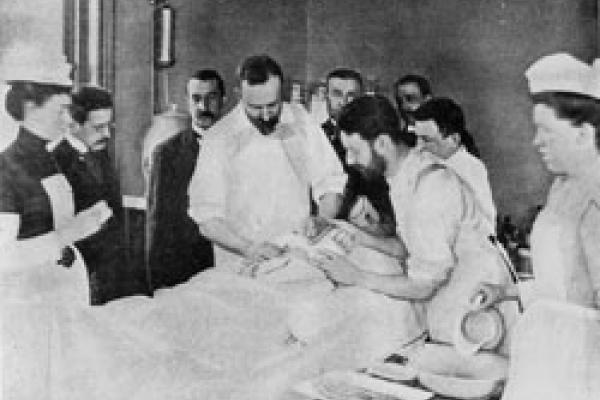TUH is renowned in the medical community for the many tests and treatments we have pioneered.
- In 1962, Drs. Ernest Spiegel and Henry Wycis were the first to treat Parkinson’s Disease with stereotactic surgery, a technique that revolutionized brain surgery (and has since been adapted to other types of surgery as well). The prototype device for stereotactic surgery that the duo created is housed at the Smithsonian Museum in Washington, D.C.
- Dr. John Lansbury established one of the first academic rheumatology units in the country. He and his colleagues made pioneering clinical and lab observations about arthritis and related diseases, such as the Lansbury Index, the first quantitative index of rheumatoid arthritis activity in the 1930s.
- One of the first tests for syphilis was invented by Dr. John Kolmer.
- Dr. Angelo DiGeorge was a Temple medical alumnus and pediatric endocrinologist who, in the 1960s, first described the genetic disorder known as DiGeorge Syndrome.
- In the 1930s, neurosurgeon Dr. Temple Fay developed the use of hypothermia to treat medical and surgical illnesses.
- Dr. Sol Sherry, who revolutionized the treatment of acute myocardial infarction through his pioneering work in thrombolytic therapy, founded Temple’s Thrombosis Research Center in 1970 and trained many of today’s leaders in the field of thrombosis and hemostasis.
- Dr. Chevalier Jackson was known as the father of bronchoesophagology and devoted his career to devising life-saving devices and procedures. The Jackson Clinic had an international reputation. At the Mutter Museum, you can see examples of the 5,000 items he personally retrieved from patients’ airways.
- Orthopedist and medical alumnus Dr. John Lachman is famous for developing the Lachman test for anterior cruciate ligament instability.
-
In 1954, Dr. Wayne Babcock was awarded the American Medical Association’s Distinguished Service Gold Medal for outstanding contributions to medicine and humanity for:
- Pioneering new surgeries and techniques, such as inguinal hernia repair, the “pull through” operation for cancer of the rectum and sigmoid colon, the “Babcock method” for treating osteomyelitis (using zinc chloride), and the hemipelvectomy for osteogenic sarcoma.
- Inventing dozens of surgical instruments, including Babcock’s viscera forceps, Babcock’s sump drain and lamp chimney sump drain, and the vein stripper.
- Using spinal anesthesia for the first time in the United States (1907) and pioneering the use of steel sutures and wire mesh for hernia repair.
- Groundbreaking research continues at TUH to this day, from HIV and AIDS to lung disease, from heart conditions to epilepsy, from cancer to trauma and emergency care.
